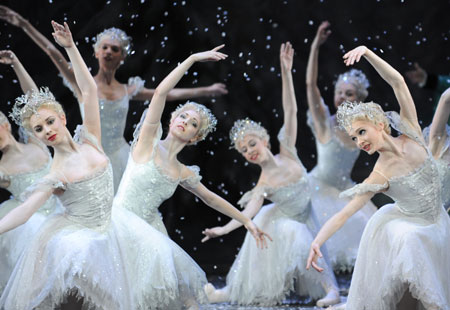Classical ballet
Harlequin and Columbina from the mime theater at Tivoli Gardens, Copenhagen, Denmark
Neoclassical ballet
Main article: Neoclassical ballet
Neoclassical ballet is a ballet style that conforms to classical
ballet technique and vocabulary, but deviates from classical ballet
through such differences as unusually fast dance tempos and its addition
of non-traditional technical feats. Spacing in neoclassical ballet is
usually more modern or complex than in classical ballet. Although organization in neoclassical ballet is more varied, the focus on structureis a defining characteristic of neoclassical ballet.Tim Scholl, author of From Petipa to Balanchine, considers George Blanchine's Apollo in 1928 to be the first neoclassical ballet. Apollo represented a return to form in response to Sergei Diaghilev's abstract ballets. Balanchine worked with modern dance choreographer Martha Graham, expanding his exposure to modern techniques and ideas, and he brought modern dancers into his company (New York City Ballet) such as Paul Taylor, who in 1959 performed in Balanchine's Episodes. During this time period, Glen Tetley began to experimentally combine ballet and modern techniques.


Contemporary ballet
Main article: Contemporary ballet
Contemporary ballet is a form of dance influenced by both classical ballet and modern dance.
It employs the fundamental technique and body control (using abdominal
strength) principles of classical ballet but permits a greater range of
movement than classical ballet and may not adhere to the strict body
lines or turnout
that permeate classical ballet technique. Many of its concepts come
from the ideas and innovations of 20th century modern dance, including
floor work and turn-in of the legs. This ballet style is often performed
barefoot.George Balanchine is often considered to have been the first pioneer of contemporary ballet through the development of neoclassical ballet. One dancer who danced briefly for Balanchine was Mikhail Baryshnikov, an exemplar of Kirov Ballet training. Following Baryshnikov's appointment as artistic director of American Ballet Theatre in 1980, he worked with various modern choreographers, most notably Twyla Tharp. Tharp choreographed Push Comes To Shove for ABT and Baryshnikov in 1976; in 1986 she created In The Upper Room for her own company. Both these pieces were considered innovative for their use of distinctly modern movements melded with the use of pointe shoes and classically trained dancers—for their use of contemporary ballet.
Twyla Tharp also worked with the Joffrey Ballet company, founded in 1957 by Robert Joffrey. She choreographed Deuce Coupe for them in 1973, using pop music and a blend of modern and ballet techniques. The Joffrey Ballet continued to perform numerous contemporary pieces, many choreographed by co-founder Gerald Arpino.
Today there are many contemporary ballet companies and choreographers. These include Alonzo King and his company, Alonzo King's Lines Ballet; Complexions Contemporary Ballet, under the direction of Dwight Rhoden; Nacho Duato's Compañia Nacional de Danza; William Forsythe, who has worked extensively with the Frankfurt Ballet and today runs The Forsythe Company; and Jiří Kylián, currently the artistic director of the Nederlands Dans Theater. Traditionally "classical" companies, such as the Kirov Ballet and the Paris Opera Ballet, also regularly perform contemporary works.
Tidak ada komentar:
Posting Komentar